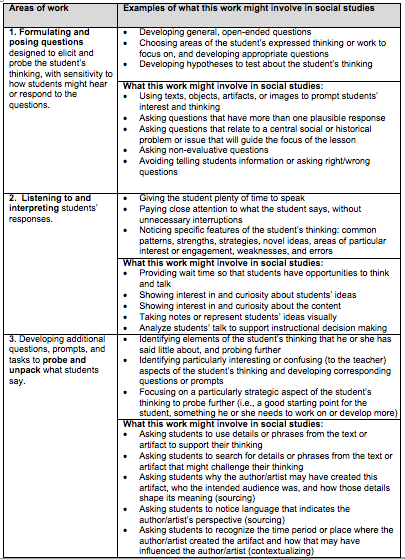What is eliciting and interpreting in social studies?
In inquiry-oriented classrooms, the process of asking questions, evaluating evidence, critiquing arguments, and constructing knowledge is shared work. To be able to work together and develop ideas, therefore, students’ thinking must be made visible so that the teacher can see where students are in their thinking and develop plans for extending students’ thinking further. Making student thinking visible also enables other students to build on or challenge their peers’ ideas and work together to construct meaning.
The video below shares an example of eliciting and interpreting individual students’ thinking about a news article in the context of a middle school investigation of whether post-apartheid South Africa has lived up to its promises.
Why work on eliciting and interpreting student thinking in social studies?
Many novice teachers have learned that the role of students in social studies is to memorize facts and learn a single story or set of information. As a result, they may tend to ask closed questions with right or wrong answers. While accurate, factual information certainly plays an important role in social studies inquiries, the practice of eliciting and interpreting individual students’ thinking emphasizes a different aspect of the inquiry process— putting students in the position of asking questions and reasoning about possible arguments or solutions. To support inquiry and develop students’ understanding of historical and social issues, teachers ask open-ended and non-evaluative questions that treat students as sensemakers. Teachers are then positioned to design experiences that build on, extend, and challenge students’ thinking and prepare students to construct or critique arguments about historical and social issues.
Because novices do not always see regular examples of open-ended questions that focus on thinking and interpretation in social studies, it is important to decompose and rehearse the practice of eliciting and interpreting individual students’ thinking in social studies teacher education. For novices, this practice is also an essential building block for setting up and managing small group work and leading a group discussion. Last, working on eliciting and interpreting individual students’ thinking provides the opportunity to work on and understand key ways of thinking in social studies (e.g., noticing multiple perspectives, considering multiple causes, recognizing contextual influences) that are a part of the inquiry process of asking questions, evaluating sources, and critiquing or developing interpretations.
Example: Eliciting and interpreting student thinking in an eighth-grade classroom
In one eighth-grade classroom, students investigated the Trail of Tears by consulting a range of historical sources and writing an evidence-based argument about the causes. The teacher began the investigation by eliciting students’ thinking about the topic of migration and displacement, asking students about experiences they’ve had with moving. The teacher then used the ideas gathered and made connections to them when sharing background relevant to understanding the Trail of Tears.
Then, the class shifted to analyzing sources and developing their own arguments about why the Trail of Tears happened, and the teacher again elicited and interpreted their thinking. As students tried to make sense of historical sources and the inquiry question, the teacher elicited their thinking by asking open-ended questions that put student thinking front and center. Eliciting allowed multiple students to share their reasoning, ask each other questions, and together develop a strong understanding of the sources. Eliciting also gave the teacher opportunities to understand how students were thinking about the sources and guide their thinking with follow-up suggestions or questions that helped students notice important issues or make connections that they had overlooked. When students read a document by then-governor of Michigan, Lewis Cass, they found the governor expressed racist sentiments toward indigenous people and assumed he was an outlier. Through the teacher’s questioning (i.e., What position did this author hold? How did he get this position? What does that tell you about the people who elected him?), the students could see that this historical source indicated that many people likely had negative views of indigenous people at the time, and that mindset may have been a contributing factor to the Trail of Tears.
This example illustrates how the practice of eliciting and interpreting student thinking can support purposeful discussions that enable teachers to understand what students know about a topic and help make connections that lead to the instructional goals.
What are the elements of the practice?
The practice can be broken down, or decomposed, into discrete, teachable parts, represented in the table below.

What does this look like in practice?
Below are sample videos that correspond to each area of work named in the table above.
1. Formulating and posing questions
2. Listening to and interpreting students’ responses
3. Probing and unpacking what students say
What is challenging about learning this practice?
Novices often struggle with eliciting and interpreting individual students’ thinking. Novices are often focused on their next instructional steps and may not pause to listen intentionally to students’ thoughts or express interest in students’ thinking. In moments like these, novices tend to give general responses to students, gloss over what students may contribute to the discussion, or not acknowledge a student’s comment at all. Furthermore, novices have trouble knowing when to respond to students’ comments.